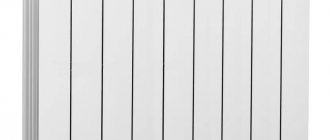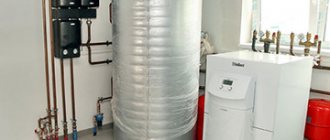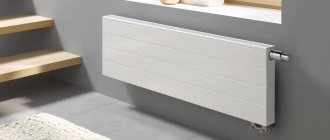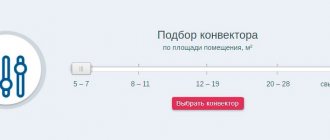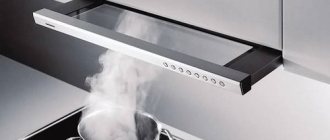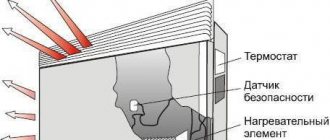For heating residential, public and industrial premises, two main types of heating devices are used - radiators and convectors. Radiators are often installed on water heating systems; they implement radiant-convective heat exchange. Convectors are used in water heating systems; in the absence of such, electric and gas convectors are used. Convectors implement convective heat transfer in operation. The power of a heating convector is not inferior to the power of a radiator; the devices have the same power calculation method.
Don't overdo it!
14-15 sections for one radiator is the maximum.
Installing radiators of 20 or more sections is ineffective. In this case, you should split the number of sections in half and install 2 radiators of 10 sections each. For example, place 1 radiator near the window, and the other near the entrance to the room or on the opposite wall. The same goes for steel radiators. If the room is large enough and the radiator is too large, it is better to install two smaller ones, but with the same total power.
If there are 2 or more windows in a room of the same volume, then a good solution would be to install a radiator under each window. In the case of sectional radiators, everything is quite simple.
14/2=7 sections under each window for a room of the same volume
Radiators are usually sold in 10 sections, it is better to take an even number, for example 8. A supply of 1 section will not be superfluous in case of severe frosts. This will not change the power much, but the heating inertia of the radiators will decrease. This can be useful if cold air often enters the room. For example, if this is an office space that clients often enter. In such cases, radiators will heat the air a little faster.
What about the cost of heating?
In accordance with the results of testing by the Rostest laboratory, the energy consumption of a convector with an inverter control unit with a power of 2 kW was 3.611 kW per day. Let's convert this into rubles and get 13.61 rubles. In the same test, a convector of the same power was tested, but with mechanical control. The energy consumption of this convector was 17.05 kW per day. We convert into rubles and get 64.27 rubles/day.
If we discard the fact that the maximum electricity is consumed in the process of reaching the set temperature (and not in the process of maintaining the set temperature) and simply record the energy consumption indicators for 30 days, we get 108.33 kW, which in rubles is 408.40 rubles.
As you can see, if the problem comes down to finding economical and efficient heating, the benefits of installing Ballu convectors become obvious even to non-professionals. It is especially relevant for owners of non-gasified houses and plots.
Let's complement the advantages of Ballu systems with their performance characteristics.
Heating convector power table
This section of the article provides a table for selecting the power of convectors depending on the area of the heated room and volume.
| Heated area, sq.m., room height – up to 2.7 meters | Convector thermal power, kW | Thermal power of the convector (ceiling height -2.8 m) | Thermal power of the convector (ceiling height -2.9 m) | Thermal power of the convector (ceiling height -3.0 m) |
| 1 | 2 | 3 | 4 | 6 |
| 10 | 1,0 | 1,12 | 1,16 | 1,2 |
| 15 | 1,5 | 1,68 | 1,74 | 1,8 |
| 20 | 2,0 | 2,24 | 2,32 | 2,4 |
| 25 | 2,5 | 2,8 | 2,9 | 3 |
| 30 | 3,0 | 3,36 | 3,48 | 3,6 |
From the table below you can select a convector according to the heated area. Heights are given in 4 options - standard (up to 2.7 meters), 2.8, 2.9 and 3.0 meters. For angular configurations of premises, an increasing factor of 1.1 must be applied to the selected value; for construction with high-quality thermal insulation, a decreasing factor of 0.8 must be applied. If the ceiling height is more than three meters, the calculation is carried out using the above method (by volume using a coefficient of 0.04).
After calculating the thermal power, heating convectors are selected - quantity, geometric dimensions and installation method. When selecting devices in rooms of large area and volume, it is necessary to take into account the characteristics and power value of each individual convector. It is necessary to be guided by the principle of increased power of the convector installed in the blockage zone of maximum heat losses. That is, a device installed along a full-profile glass display case should have a higher thermal performance value than a convector placed near a small window or an external wall.
https://youtube.com/watch?v=8KGULWaXw_o
Manufacturers, characteristics and prices
Electric convector heaters are produced by several companies that produce other household appliances - Electrolux, AEG, Hyundai, Stiebel Eltron, Zanussi. In addition, there are many companies that specialize in this type of technology or produce two or three more groups of products. Among them there are Russian manufacturers - Ballu, Termica, Ural-Mikmah-Term, Alvin. There is also a whole group of European brands:
- Airele, Noirot and Atlantic (France),
- Extra, Royal Thermo, Scoole, Timberk, WWQ (PRC),
- Frico (Sweden),
- NeoClima (Greece),
- Nobo (Norway)
and many more. Electric heating is the norm in Europe; water heating is rare here. Hence the number of companies producing such household appliances. But, as is usual in recent years, most companies have moved production to China, so the assembly is mainly Chinese, although quality control should be at the level.
Electric heating convectors can have a power from 0.5 kW to 2.5-3 kW. They operate mainly from a 220 V network; if necessary, three-phase ones can be found - from 380 V. With increasing power, the dimensions (mainly depth) and price increase. If we talk about prices on average, then the price for imported electric convectors is about $80-250, for Russian ones - $30-85.
| Name | Power | Additional functions | Installation type | Control type | Heating element type | Dimensions (D*W*H) | Price |
| AEG WKL | 0.5/1/1.5/2/2.5/3 kW | overheat protection | Wall | Thermostat | heating element | 78*370*450 | 105 — 195 $ |
| Airelec Paris digital 05DG | 0.5 kW | overheat protection | Wall | Electronic | Monolithic | 80*440*400 | 60-95 $ |
| Termica CE 1000 MR | 1 kW | Overheat protection + ionizer | Floor | Thermostat (mechanical) | heating element | 78*400*460 | 50 $ |
| Nobo C4F 15 XSC | 1.5 kW | Overheat and tip-over shutdown | Wall/floor | Electronic | heating element | 55*400*975 | 170 $ |
| Stiebel Eltron CS 20 L | 2 kW | Overheat protection + fan | Floor | Thermostat (mechanical) | spiral heating element | 100*437*600 | 200-220 $ |
| Stiebel Eltron CON 20 S | 2 kW | overheat protection | Floor | Thermostat (mechanical) | Stainless steel heating element | 123*460*740 | 450 $ |
| Noirot Melodie Evolution1500 | 1.5 kW | Overheat and tip-over shutdown | Wall-mounted (small height) | Electronic | Monolithic | 80*220*1300 | 300-350 $ |
| Ballu BEC/EVE – 1500 | 1.5 kW | Overheat and tip-over shutdown | Wall/floor | Electronic | Heating element Double G Force | 111*640*413 | 70 $ |
| Timberk TEC.PF1 M 1000 IN | 1 kW | Overheat and tip-over shutdown + ionizer | Wall/floor | Thermostat (mechanical) | Needle + quiet + economical | 100*410*460 | 65 $ |
| Dantex SD4-10 | 1 kW | Overheat and tip-over shutdown | Wall/floor | Electronic | Needle + quiet + economical | 78*640*400 | 45 $ |
Let's talk about calculations in more detail
This issue can be dealt with quite easily. First of all, it is worth clarifying for what purposes a convector is needed: as additional heating or as a source of main heat in the room.
In the case of installing a convector as the only source of heat supply, it is worth taking into account the figure of 40 W per cubic meter. This means that to heat one cubic meter of space it will be necessary to spend forty watts of energy. So how to calculate the power of a heating convector? For a complete calculation, you need to know the dimensions of the room: ceiling height, length and width of the room. By multiplying all the data, we get the volume of the room, then we multiply this figure by forty and get the value of the required power.
Advice. You should not use a simple form for calculations, which takes the value of one hundred watts instead of forty. In this case, you can make a serious mistake. After all, multiplying the volume by one hundred watts does not take into account the height of the ceiling
We can say that this is not so important, but the power consumption of the convector will then be determined incorrectly. In country houses or in old houses, the ceiling height is impressive and this can have a huge impact on heating
The formula will be calculated incorrectly, the power will be low and, as a result, the heating device simply will not cope with its task. Therefore, you need to take into account the slightest nuances when calculating.
Calculation example
For clarity, let’s do a little calculation: you need a convector to heat a room with a window, an area of 10 square meters, and a ceiling, an area of 4 meters. We substitute the values into the formula and get: 10 multiplied by 4 and multiplied by 40 (10*4*40) as a result we get 1600 watts. The maximum power for such a room will be 2 kW.
One more important note. The convector should be installed directly under the window (under the window sill), so the cold air from the window will immediately heat up, thereby not cooling the temperature in the room
In the second case, when the convector is installed as an additional source of heat in the room in case of severe cold, intermittent heat supply through the centralized heating network, the calculation of the convector power is slightly different.
To calculate the power, the formula given above substitutes the value not forty watts, but twenty-five or thirty-five, it all depends on the area of the room and the size of the ceiling. Accordingly, for a small room we take the value twenty-five and for a large room we take the value thirty-five.
Let's calculate
.
The area of the room is 20 square meters and the ceiling height is three meters, we get (20*3*25) = 1500 kW. From the calculations it is clear that the power of the convector should be from one to one and a half thousand kilowatts. Therefore, we take the average value and get the convector power of 1.25 kilowatts. Helpful hint for checking calculations
By following these tips, you can purchase equipment that will always delight you with its warmth.
It is worth noting that there are several options for convectors:
- Floor.
- Wall.
Each of them has its own qualities and disadvantages. Thus, a floor convector is a universal means of heating; it can be installed anywhere on the floor. This could be an office, hallway, storage room. In general, there are many accommodation options and each of them brings warmth for both one person and several.
The wall convector is installed only under the window, forming thermal insulation.
Don't forget about stable voltage. Not every company or organization, as well as home, can boast of stable voltage. Sometimes there are fluctuations in the network, which can lead to breakdowns for many electrical appliances. To prevent such cases, it is necessary to take care of protection against changes. There are two options for solving this problem: a relay-interrupter and a stabilizer. Both devices do their job well, ensuring continuous operation of all electrical appliances, including the heating convector.
If you prefer the video instruction format, watch the video below. In it, Alexander Yarygin (the director talks about the correct calculation of equipment power, shares tips from practice).
We hope that the material was useful to you. We will be very grateful if you click on the social media buttons.
Traditional water heating in our country is complex and expensive at the installation stage. Therefore, many are looking for other options for heating rooms, cottages, cottages and apartments. The first thing that comes to mind is electric heating convectors. Installation is super simple: set it up or hang it up, plug it into a power outlet. All. You can warm up. The only limitation is whether the wiring can withstand such a load. The second is decent electricity bills, but they can be reduced by installing.
Gas heating
Things are not much better with gas heating. The costs of its construction are comparable to the costs of organizing electric heating (with an electric boiler and liquid coolant).
But if you are “lucky” to purchase a plot that is located in an area with poorly developed engineering infrastructure, add to the total costs the costs of connecting a gas pipeline to your home (the cost of gas pipelines, the cost of developing design documentation and other inevitable expenses). For the Moscow region this is:
- costs for design and approval of project documentation with its subsequent registration - 20 thousand rubles;
- installation of gas pipelines - from 3 to 50 thousand rubles);
- tie-in into the gas supply pipeline – 30 thousand rubles;
- commissioning of a gasified facility with the participation of supervisory and control organizations - 50 thousand rubles.
To this should be added the cost of obtaining the necessary permits, approvals and technical conditions (which, by the way, are also needed when building a classic heating system with an electric boiler). In the end, this is plus another 50...100 thousand rubles (according to the most conservative estimates).
Total: 149 thousand rubles. (heating installation) plus 250 thousand rubles. (gasification of the site). We receive a “tidy” sum, which is close to 400 thousand rubles.
There is no doubt that if a person managed to buy a house already gasified, then he was really lucky. Indeed, in cold weather, the average bill for gas heating in the Moscow region in the winter of 2022 ranged from 6 to 8 thousand rubles. (we are talking about houses with an area of 100 m²).
Basic data
Accurate thermal calculations are quite complex, and they are done by specialists when designing a heating system. If ordering it is problematic, you can do a simple calculation yourself.
To complete it you need to have basic information:
- Initially, you need to know the dimensions of the room where the heating radiators will be installed:
- Length.
- Width.
- Height.
- Then you need to decide on the choice of batteries:
- steel plate;
- cast iron;
- bimetallic;
- aluminum.
- In the technical documentation for each radiator, the characteristics from the manufacturer indicate the thermal power of the device. This is the amount of heat in watts that can be generated by 1 modular section element in 1 hour.
For reference, one watt is equivalent to 0.86 calories of heat.
- To calculate the power of radiators, it is necessary to use the standard heat transfer values of each section, namely:
- For Soviet-made cast iron batteries - 160 W.
- Aluminum with a center height of 500 mm - 200 W.
- Non-dismountable steel panels with a length of 500 and 800 mm, respectively, 700 and 1500 W.
How to calculate the power of convectors by area?
In accordance with building codes, the rated power of a convector for a room is 25 sq. m will be:
(25 sq. m: 10 sq. m) * 1 kW = 2.5 kW
25 sq. m * 0.1 kW = 2.5 kW
The obtained result is given without taking into account the characteristics of the room. To improve calculation accuracy, consider the following factors:
- placing the convector under a window reduces heat transfer, so to compensate for heat losses, choose equipment that is 5–10% more powerful;
- if the windows occupy a large area of the wall (panoramic, French), and also face north and northeast, when calculating, increase the result by 15%;
- the corner location of the room requires an increase in power by 20%, and if there are 2 windows in such a room, the result obtained increases by 30%.
The table of increasing coefficients will help you make your calculations more accurate :
| Feature of the room | Coefficient |
| Lack of wall insulation | 1,1 |
| Installing a convector under a window | 1,05 |
| Installation of a convector in a corner room with 1 window | 1,2 |
| Installation of a convector in a corner room with 2 windows | 1,3 |
| Availability of single-layer double-glazed windows | 0,9 |
| Ceiling heights from 2.8 to 3 m | 1,05 |
Let us calculate the power of an electric heating convector for a corner room with two external walls and an area of 18 square meters. m:
(18 sq. m * 0.1 kW) * 1.2 = 2.16 kW
In some regions, climatic features are taken into account when calculating, but in central Russia the weather coefficient is 1.0.
How can you save money?
It is, of course, unreasonable to completely abandon the benefits of modern life, but in order to save money, you can pay attention to energy-saving refrigerators, because this device will work all year round, regardless of weather conditions. If you calculate how much energy a TV and computer consume per month, you can completely influence this amount by choosing one working device
Often, a switched-on monitor works all day without any benefit, and a running TV becomes the background against which we carry out everyday activities. Getting rid of such habits is not easy, but within a month it will give results in the form of a reduced energy bill.
Other methods to save electricity:
Replace all lighting fixtures with new energy-saving or LED lamps. The initial investment will pay off handsomely with serious savings and a long service life. If you use an electric kettle frequently, always add only as much water as needed, and not in reserve. Unfortunately, energy-saving kettles have not yet been invented, but it is entirely within your power to adjust the mode of use. Place your computer in comfortable standby mode. In this case, it turns off automatically if a certain amount of time passes without operation.
When turned on, it will accordingly consume less energy, which is also important. Defrosting the refrigerator and freezer on time is also part of family savings. When a significant amount of ice forms on the walls, energy consumption increases, so be sure to eliminate this factor. The use of heat-reflecting screens will help make heaters and convectors work more efficiently. Replacing wiring and organizing local lighting in the kitchen or recreation area will also significantly reduce costs. The use of adapters and extension cords increases energy consumption. When purchasing new electrical appliances, it is better to give preference to the economical consumption class
The main positions are shown in the table.
One of the less common ways to save electricity is the installation of multi-tariff meters. This will allow you to turn on some appliances at night, when electricity costs less. This practice has shown itself to be excellent in foreign countries, but unfortunately, it has not yet taken root here.
It is probably impossible to completely abandon the use of electrical appliances in the modern world. Even a gas boiler and heating convector must consume a certain amount of energy to function. If we are talking about a welding machine, boiler or air conditioner, the consumption is significant even with short-term use. Despite this, consumers are buying more and more different electrical appliances, so it would be useful to find out the main “culprit” of electricity bills, as well as proven methods of reasonable savings that will help reduce costs.
Costs for the construction and operation of a heating system with an electric boiler
Currently, many owners of private households are inclined to use electric heating systems. There are several reasons for this:
- lack of developed gas supply networks near a construction site under construction or already in operation.
- practicality and ease of management;
- availability and relatively low cost of heating boilers.
Having planned the construction of a heating system, the “heart” of which is an electric boiler, owners of private households are well aware of future operating costs. We are talking about high energy costs for heating the coolant liquid. This is an inevitability that anyone who decides to install a seemingly inexpensive electric boiler will face.
For your information: an electric boiler with minimal functionality and capable of heating a house of 100 m² can be bought today for 5,000...8,000 rubles. But are the costs of organizing heating systems with electric boilers really “democratic”? Let's look at an example:
- the cost of a completely ordinary electric boiler is 8,000 rubles, while the cost of good branded equipment averages 40,000 rubles;
- the purchase of consumables and additional equipment (towel rails, pipes, fittings, etc.) for a house with the specified area will cost approximately 45,000 rubles. (this is the average cost, which may differ depending on the ambitions of the manufacturer);
- the cost of installation work is 64,000 rubles. (prices of the electronic service for selecting masters).
Total: 149 thousand rubles.
As you can see, the cost of installing radiators, pumps and other equipment completely destroys the optimism that the owner of the house may have due to the low cost of electric heating boilers.
Now let's calculate the costs of heating the premises. The average energy consumption of a system with an electric heating boiler in the cold season is 116 kW per day (we are talking about houses with an area of 100 m²). Minimum cost of one kWh. electricity in the second half of 2022 for the Moscow region is 3.77 rubles. This is data on a single-rate tariff for private houses located on the territory of gardening and other non-profit associations (information taken from the official website of Mosenergosbyt JSC). Other categories of consumers pay higher tariffs for electricity.
After simple mathematical calculations, we get: the minimum cost of electric heating costs is 13,119 rubles. per month.
Heating system options
So, let's look at existing equipment that will make electric heating in the house economical and cheap.
Using the boiler
Installing an electric boiler, which will heat water in the home heating system, warming up the room, is the first, least effective option. Of course, on the Internet you can see a bunch of information that talks about economical boilers that can reduce consumption by up to 80%, but all this is nonsense. The only option to reduce costs is to install thermostats and various automation systems, which will turn on only when the temperature in the room drops, as well as at certain times of the day. All other talk about new product designs or reduced power is just a publicity stunt. If you buy a small-power boiler, it will take more time to heat the water for heating the house, so that’s what it will do.
Using IR Panels
Installing infrared heaters is a more reasonable solution and, most likely, the most profitable. The fact is that these products do not heat the air in the room, but certain objects (floor, walls, closet), from which heat is subsequently transferred. If in the previous version the hot air will rise to the ceiling and immediately cool down, then in this case the heat is directed to the floor, which is more reasonable (people do not walk on the ceiling).
This diagram shows the efficiency of an economical heating system for a private home:
You see everything for yourself, so there is nothing more to prove. It should only be noted that IR devices can work more efficiently if you add thermostats to them. One regulator is enough to control three heaters in an economical heating system for a private home. We talked about how to connect a thermostat to an infrared heater in a separate article.
Using convectors
Many manufacturers convince us that an electric convector effectively heats a room and at the same time consumes a small amount of electricity. The issue is of course controversial, because, in fact, the principle of operation of the products is similar to the option with radiators (the air rises upward). The advantage of convectors is that their installation and connection are not difficult. In addition, heating of the heating element takes about one minute, which is undoubtedly faster than in the case of water radiators.
Other advantages of electric convectors include:
- low cost (from 2 to 10 thousand rubles);
- fire safety (which is especially important when installing heating in a wooden house);
- you can gradually increase the heating system (one convector for a room is not enough, buy another one and connect it to the network without any problems);
- attractive appearance;
- trouble-free operation during power surges (also important in the private sector);
- compact sizes.
Separately, I would like to recommend that you explore a heating option such as electric heated floors. You can find out a review of this heating system by watching the video:
Application of heated floors
We analyzed reviews from customers who used this option and saw that most people were satisfied with the purchase. The main thing is to additionally install a temperature regulator in order to make economical electric heating in the house with your own hands.
What is convection and convector
Heating convector
Convection is the movement of air masses due to differences in densities (and, accordingly, masses). Cold air entering the room moves downwards. Heating devices are concentrated in the lower sector of the premises - the air heats up, passing through the structures of convectors (radiators), acquires less density and mass, and rises. In this way, the process of convective heat exchange occurs. Its benefit is that there is no power to move air; everything happens naturally.
Main advantages of convectors:
- No hot surfaces;
- Possibility of working on electricity (in the absence of other energy sources);
- Attractive appearance;
- Embedding in building structures - floors, plinths - allows you to save space;
- Convectors have a mobile version (movable);
- High-quality control - remote, programmable, and so on.
A convector is a heating device that operates using the principle of convective heat exchange. The device has a simple design and consists of the following main parts:
- Metal casing with protective grille and air inlet holes;
- Heating component – electric, water or gas;
- Control system.
The air enters the casing through special openings, heats up and leaves the convector through the protective grille. To increase thermal power, some types of convectors are equipped with built-in fans that increase the air flow. Such convectors are superior to radiators in terms of operating efficiency.
Based on the installation method, there are floor-mounted, wall-mounted and built-in convectors. Built-in convectors are installed in the floor and in the baseboard sector of the room. Depending on the type of energy carrier used, there are three types of convective heaters:
- Water heating convectors;
- Electric heating convectors;
- Gas convectors.
Water convectors use a tubular finned heat exchanger as a heating element, through which the coolant moves, giving off heat to the heated air. The heat exchanger is most often made of copper, which is neutral to the influence of external negative factors - corrosion, low quality coolant, and so on. Due to the fins, the heat transfer area increases.
The same principle is implemented in electric and gas convectors; they differ only in the design of the heating element. Electric convectors use needle, heating element and heaters built into a monolithic complex; gas convectors use a burner and a heat exchanger. Each type of convector has its own characteristics.
Water is considered the best option, but requires the installation of supply pipelines. Using water coolant is the most economical option among competitors. An electric convector is easy to install and operate, but the electrical power consumed by the convector significantly increases the amount of energy costs. A gas appliance requires compliance with the rules for the operation of devices operating on natural gas and connection to the gas pipeline.
Convector design
Methods for determining the electricity consumption of household appliances and tools
The average electricity consumption in citizens' apartments per month is the sum of the total electricity consumption of all electrical appliances used by its residents. Knowing the electricity consumption for each of them will give an understanding of how rationally they are used. Changing the operating mode can provide significant energy savings.
The total amount of electricity consumed per month in an apartment or house is recorded by the meter. There are several ways to obtain data for individual devices.
A practical way to calculate electricity consumption based on the power of an electrical appliance
The average daily electricity consumption of any home appliance is calculated using the formula; just remember the basic characteristics of electrical appliances. These are three parameters - current, power and voltage. Current is expressed in amperes (A), power in watts (W) or kilowatts (kW), and voltage in volts (V). From the school physics course, we remember how electricity is measured - it is a kilowatt-hour, it means the amount of electricity consumed per hour. All home appliances are equipped with labels on the cable or on the device itself, which indicate the input voltage and current consumption (for example, 220 V 1 A). The same data must be present in the product passport. Based on current and voltage, the power consumption of the device is calculated - P=U×I, where
- P – power (W)
- U – voltage (V)
- I – current (A).
We substitute the numerical values and get 220 V × 1 A = 220 W.
Next, knowing the power of the device, we calculate its energy consumption per unit of time. For example, a regular liter electric kettle has a power of 1600 W. On average, he works 30 minutes a day, that is, ½ hour. We multiply the power by the operating time and get:
1600 W × 1/2 hour = 800 W/h, or 0.8 kW/h.
To calculate costs in monetary terms, we multiply the resulting figure by the tariff, for example, 4 rubles per kWh:
0.8 kW/h×4 rub.=3.2 rub. Calculation of the average monthly fee - 3.2 rubles * 30 days = 90.6 rubles.
In this way, calculations are made for each electrical appliance in the house.
Counting electricity consumption using a wattmeter
The calculations will give you an approximate result. It is much more reliable to use a household wattmeter, or energy meter - a device that measures the exact amount of energy consumed by any household device.
Digital wattmeter
Its functions:
- measuring power consumption at a given moment and over a certain period of time;
- current and voltage measurement;
- calculation of the cost of consumed electricity according to the tariffs you have set.
The wattmeter is plugged into a socket and the device you are going to test is connected to it. The display shows power consumption parameters.
Current clamps allow you to measure the current and determine the power consumed by a household appliance without disconnecting it from the network. Any device (regardless of manufacturer and modification) consists of a magnetic circuit with a movable disconnect bracket, a display, a voltage range switch and a button for recording readings.
Measurement procedure:
- Set the desired measuring range.
- Open the magnetic circuit by pressing the bracket, place it behind the wire of the device under test and close it. The magnetic core must be located perpendicular to the power wire.
- Take readings from the screen.
If a multi-core cable is placed in the magnetic core, the display will show zero. This happens because the magnetic fields of two conductors carrying the same current cancel each other out. To obtain the required values, measurements are carried out on only one wire. It is convenient to measure energy consumption through an extension cord-adapter, where the cable is divided into separate cores.
Determining energy consumption using an electric meter
A meter is another simple way to determine the power of a household appliance.
How to count light using a meter:
- Turn off everything in the apartment that runs on electricity.
- Record your readings.
- Plug in the desired device for 1 hour.
- Disable it and subtract the previous readings from the received numbers.
The resulting number will be an indicator of the electricity consumption of the individual device.
Calculation of convector power by room volume
According to the provisions of SP 60.13330.2012, to heat rooms with very high and low ceilings, 41 W per 1 cubic meter is required. m volume. Knowing the length, width of the room and ceiling height, you can calculate the heating power using the calculator using the formula:
where abc is the formula for calculating volume;
0.041 kW – thermal energy standard.
Let's calculate the power of the convector for a 3x4 m room with 2 m ceilings:
(3*4*2) * 0.041 = 0.984 kW
To heat such a room, you will need a 1 kW convector (without taking into account increasing factors).
We inform you about the creation of BIM models of Techno Usual in-floor convectors for the Revit system. The family implements two selection methods, two levels of detail, as well as... | October 1, 2020
At the exhibition we will present the entire range of our products. We are waiting for you at our stand A5091! For free admission to the exhibition, you must register with... | January 14, 2020
We present a new color for decorative grilles made of anodized aluminum – “cognac”. Details are in the “Decorative Grilles” section... | July 12, 2019
Moscow, st. Malaya Semenovskaya, 9, building 3
from 10:00 to 18:00 on weekdays
Moscow region, Vostryakovo microdistrict (Zaborie village), st. Ryabinovaya, building 10, Agrocomplex
Contact person at the warehouse: Maxim
Convectors are the main heating devices for heating residential, public premises and industries. Most often, when installing high-quality internal heating, the choice falls on convectors, since they provide a highly efficient and uninterrupted heat source capable of heating rooms of any purpose and size.
An important factor after choosing the type of convector is calculating its power.
Let's consider 2 options for calculating the power (W) of the convector
The selection is based on the area of the room. (not a competent approach, overpayment by 2-3 times)
This option for calculating the power of a convector is not correct (explanation at the end of the section), but it is often used and therefore we will consider it too.
To make calculations, you will need to collect the necessary data, on which the correctness of the results will depend.
Convector power calculation
When choosing such a device, the main performance characteristic is power. It is determined based on the size and configuration of the room in which the heater is supposed to be installed. There are several approaches to determining the required power.
Based on the area of the room
It is generally accepted that for a room with one door, one window and a flow height of 2.5 m, 1 kW per 10 m2 of area is required. This approach is approximate and subject to adjustment through correction factors (k). For example, if the room is located in the corner of the building, that is, it is surrounded on both sides by external walls, then when calculating the power, the correction k = 1.1 is applied.
If the room has good thermal insulation, you can use a reduction factor of 0.8 or 0.9.
Example 1. It is necessary to calculate the power of a convector for installation in a room with an area of 25 m2, with low ceilings (approximately 2.5 m), located in the corner of a building with walls that have double thermal insulation. The room has one window and one door.
Then the power P will be calculated by the formula: P = 1 kW * (25 m2/10 m2) * 1.1 * 0.8 = 2.2 kW.
By room volume
This approach allows you to more accurately determine the power of the device, since it takes into account the height of the heated space. The idea is that heating each cubic meter of air requires 40 W of device power. To determine the final value, the same coefficients as described in the previous case are applied. It is also worth clarifying the power value if there is more than 1 window in the room - each subsequent one requires an increase in the power of the device by 10%.
Example 2. You need to select the power for a living room located in the middle part of a building with well-insulated walls. The living room has 2 windows, the height of the room is 2.7 m, the length is 7 m, and the width is 4 m.
Let's calculate the power:
P = 2*2.7*7*0.8*40 = 1209.6 W = 1.21 kW.
As an additional source of heating
If the house has central heating, the power of which is not enough to maintain a comfortable temperature, a convector can be used as an additional heat source.
In this case, a power of 40±10 W is required for each square meter of area or 15–20 W for each cubic meter.
Auxiliary heating calculation
If the house already has centralized heating, then no convectors are needed here. But if the heating system works very poorly, you should take action - we use convector heaters as auxiliary equipment. It will be very easy to calculate the required power - it is equal to half the power of full heating. For example, for an apartment of 100 square meters. m. 5 kW convectors will be required.
In a similar way, you can calculate by volume - count the convectors for the entire area based on the formula 20 W per 1 cubic meter. m.
Traditional methods of skin lightening
Only with comprehensive lightening of the face and body will the effect look organic. Milk baths are suitable for this.
. All fermented milk products contain acids and compounds that reduce the number of melanocytes - cells that produce melanin. These cosmetic procedures do not require huge investments. For one session, 1.5 liters of fresh milk and about 30 grams of honey are enough.
Milk bath
How to make a milk bath at home:
- Milk (exclusively homemade) is heated to a pleasant warmth, but not boiled - otherwise there will be no effect;
- The specified amount of honey is dissolved in hot liquid. Buckwheat is considered the most useful for the procedure - it is rich in active substances and has an increased amount of vitamin compounds. At worst, you can take acacia, but in no case synthetic;
- The prepared concentrate is poured into a bathtub filled with water at 39 degrees (it feels warm, but not hot). Afterwards you can lie down in the liquid and enjoy for 30 minutes;
- When time has passed, it is additionally recommended to wipe yourself with cucumber lotion. You can repeat sessions daily or at least 12 times a week.
It is important to remember that before you make your skin pale at home, check the components of the masks for allergenicity. Apply the product to an inconspicuous area of the body and wait 20 minutes
If during this time there is no redness or itching at the site of use, you can safely apply it to your face.
Even dark skin can be made quite pale if you wipe it with a slice of lemon
.
Some girls use orange zest tincture for the same purpose, but it has a strong drying effect. After wiping, you need to wait about half an hour and rinse off any remaining product with cool water. Repeat every day (best in the morning). Lemon for pale skin
If you are allergic to citrus fruits, an analogue of this method is rubbing with a slice of aromatic melon
. With its help, the skin is saturated with essential acids, mineral compounds and vitamins (in particular, PP, which protects against UV rays and brightens it). You need to use melons in the same way as lemon.
To get beautiful and matte white skin, girls used to use a decoction of chamomile and linden
. Take a glass of dried flowers for half a liter of water. To preserve beneficial properties, the plants are not boiled, but infused in hot water for 2 hours. The resulting liquid should be washed off the body and face every evening after a shower.
An unusual combination of castor oil and hydrogen peroxide gives a bright pallor to the entire body. These products are combined in equal proportions and applied using a sponge. You don’t have to rinse it off – the main thing is to distribute the solution evenly. Conveniently, this method is suitable for lightening the delicate skin under the eyes, in the bikini area and armpits.
Features of floor convectors
Floor heating devices are reliable sources of thermal energy. This progressive type of heating is relevant primarily because it ensures uniform distribution of warm air throughout the room. During operation, energy losses are minimal.
Design
The “heart” of a water heating convector is a pipe passing between the ribs of aluminum plates. Thanks to maximum fins, the efficiency of the device is improved, that is, heat transfer is increased. This indicator is primarily affected by the intercostal distance. If it is significant, the heating water circuit will be easier to maintain.
The heat exchanger pipe is located in a protective casing, closed with a special grille. In addition, each heater has a valve for air removal and connection points. In their design, floor products are similar to wall products - they are a non-separable solid block with a low level of thermal stress. Despite its compact size, the power of the device is sufficient for effective heating.
Operating principle
The operating principle of this type of heater comes down to natural air circulation. Floor-standing models are equipped with special legs that allow you to install the device at a minimum height. This is necessary for stable circulation of hot air from floor to ceiling. When compared with traditional central heating radiators, floor-standing devices have an original method of heat transfer: in electric convectors it is circulation, and in radiators it is thermal radiation.
The air first enters the convector, heating up and increasing in volume, after which it returns and goes to the ceiling. New flows of cold air follow and also heat up. This continues until the room is completely warmed up.
Application area
The convector can be installed in a central or autonomous water heating system. Compared to standard batteries, floor heaters are more economical. They are installed in rooms with a large area, as they are capable of generating a lot of thermal energy in a short time.
It is also important to use them in places where there is display glazing (panoramic windows, French doors, and so on). This type of convector is indispensable if you are planning an original design solution in the area under the window sill. For buildings with panoramic windows, Heatmann brand products are suitable, which have proven themselves to be excellent.
Advantages
Floor-standing, however, like in-floor installations, have a lot of positive qualities, thanks to which they have become widespread. When connecting such a convector, the house will always be warm, and the interior will remain presentable. Nowadays, many manufacturers produce various convectors: Isoterm, Gekon, PrimoClima, Hitman, Varmann and so on. Each company's models have their own characteristics.
The following advantages of the equipment are highlighted:
- Design. Manufacturers produce many models that differ in their appearance. As a rule, the devices have strict and elegant box shapes, so they easily fit into any interior.
- Compact and easy to maintain. Connecting a heating device is not difficult, in addition, the device will not take up much usable space.
- Uniform and fast heating of rooms. The device will work until all the air in the room is warmed up.
- Energy saving. Most manufactured models are equipped with a thermostat, with which the required power is set. This allows you to set a more efficient mode, while saving on resources.
- Fire safety. Manufacturers provide devices with various protective mechanisms.
- Value for money. Many buyers choose such heaters if it is not possible to install a traditional wall-mounted model. Floor heating convectors have different prices, which start from 1,750 rubles.
Many modern devices differ in functionality. In addition to the main task of heating the room, they are able to further purify the air.
Flaws
Despite all the advantages, modern heaters also have disadvantages that should be considered before purchasing.
The disadvantages are:
- Due to constant air circulation, the room can become dusty faster.
- You cannot use a convector and an artificial ventilation system at the same time.
- Not suitable for rooms with high ceilings. The devices are not capable of actively heating the air in the lower part of the room under such conditions.
As you can see, there are not many shortcomings, and they are not particularly critical. When choosing, it is best to pay attention to multifunctional models, the features of which make it possible to neutralize the negative qualities of heaters.
Summary table of units of measurement
| Physical quantity | Non-systemic unit | SI unit | Transition from a non-systemic unit to an SI unit |
| Activity of a nuclide in a radioactive source | Curie (Ci) | Becquerel (Bq) | 1 Ci = 3.7⋅1010 Bq |
| Exposure dose | X-ray (R) | Coulomb/kilogram (C/kg) | 1 P = 2.58⋅10−4 C/kg |
| Absorbed dose | Glad (glad) | Gray (J/kg) | 1 rad = 0.01 Gy |
| Equivalent dose | rem (rem) | Sievert (Sv) | 1 rem = 0.01 Sv |
| Exposure dose rate | Roentgen/second (R/s) | Coulomb/kilogram (in) second (C/kg s) | 1 R/s = 2.58⋅10−4 C/kg s |
| Absorbed dose rate | Rad/second (Rad/s) | Gray/second (Gy/s) | 1 rad/s = 0.01 Gy/s |
| Equivalent dose rate | rem/second (rem/s) | Sievert/second (Sv/s) | 1 rem/s = 0.01 Sv/s |
| Integral dose | Rad-gram (Rad g) | Gray kilogram (Gy kg) | 1 rad g = 10−5 Gy kg |
Formula for calculating the thermal load taking into account the temperature difference
To more accurately determine the required thermal power of a heater or convector, we recommend using the following formula.
V (room volume) x T (temperature difference) x φ (heat loss coefficient) = kcal/h
Where:
- V is the volume of the room mentioned above: width * length * height.
- T (temperature difference) – depending on the climate zone, the temperature outside can be -5 C or -30 C. Therefore, a parameter was introduced into the formula to express the difference between the average winter temperature outside and the desired temperature indoors. Example: the average winter value outside is -15C, and in the room 25C is required - it turns out T = 40C.
- φ – coefficient of heat loss of premises depending on the design and insulation. 3-4 – lack of thermal insulation. Simple wooden or metal buildings without insulation.
- 2-2.9 – low thermal insulation. Single brick masonry, simplified building design, single windows.
- 1-1.9 – average thermal insulation. Buildings with two bricks, standard buildings, ordinary roofing, a small number of windows.
- 0.6-0.9 - high thermal insulation. Few windows, double glazing, brick walls, double insulation, insulated roof and thick subfloor.
To obtain the power value of a convector or heater in kilowatts, you need to divide the resulting number by 860.
An example of calculating the thermal power of a Briz model convector
We will build an example calculation on several variants of the model, using different size data. The height of the devices is in the range of 80 - 120 mm, depth - 200 - 380 mm, length from 0.8 to 5 m (5000 mm). A convector with dimensions of 200 x 80 mm has a heat output of 340 W per meter of length. We multiply the area of the room by 100, thus obtaining the total heat energy requirement of the room. We divide the result by 340 - as a result, we see what the total length of the convectors should be. This result can be divided by the length of one of the selected products - you will get their number in pieces.

